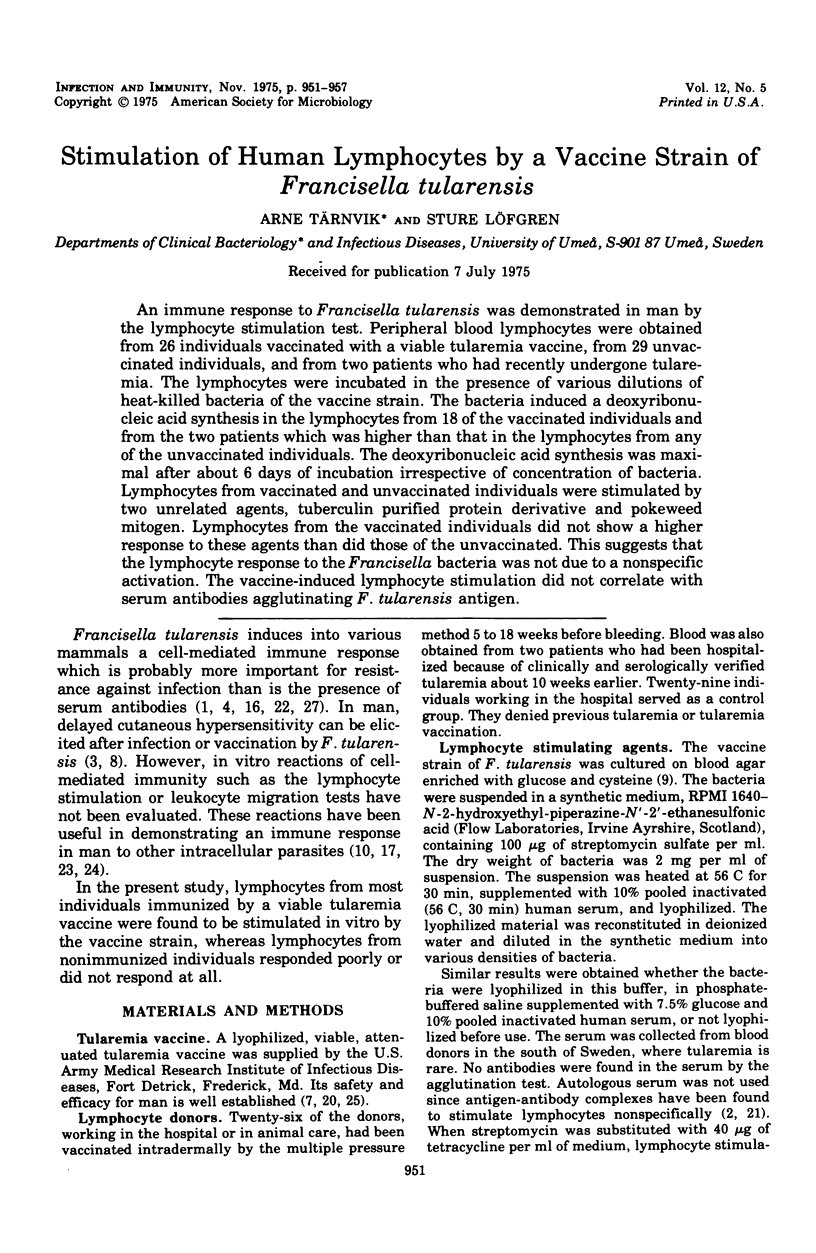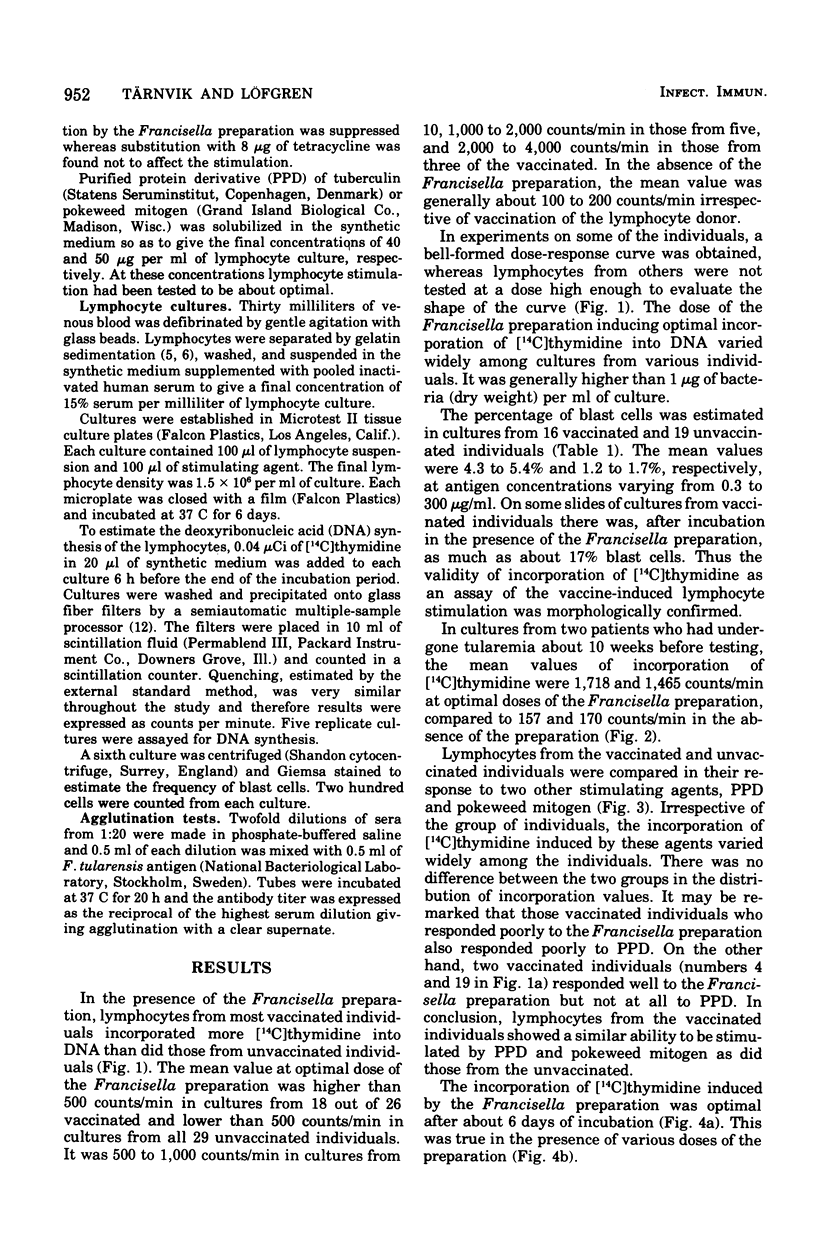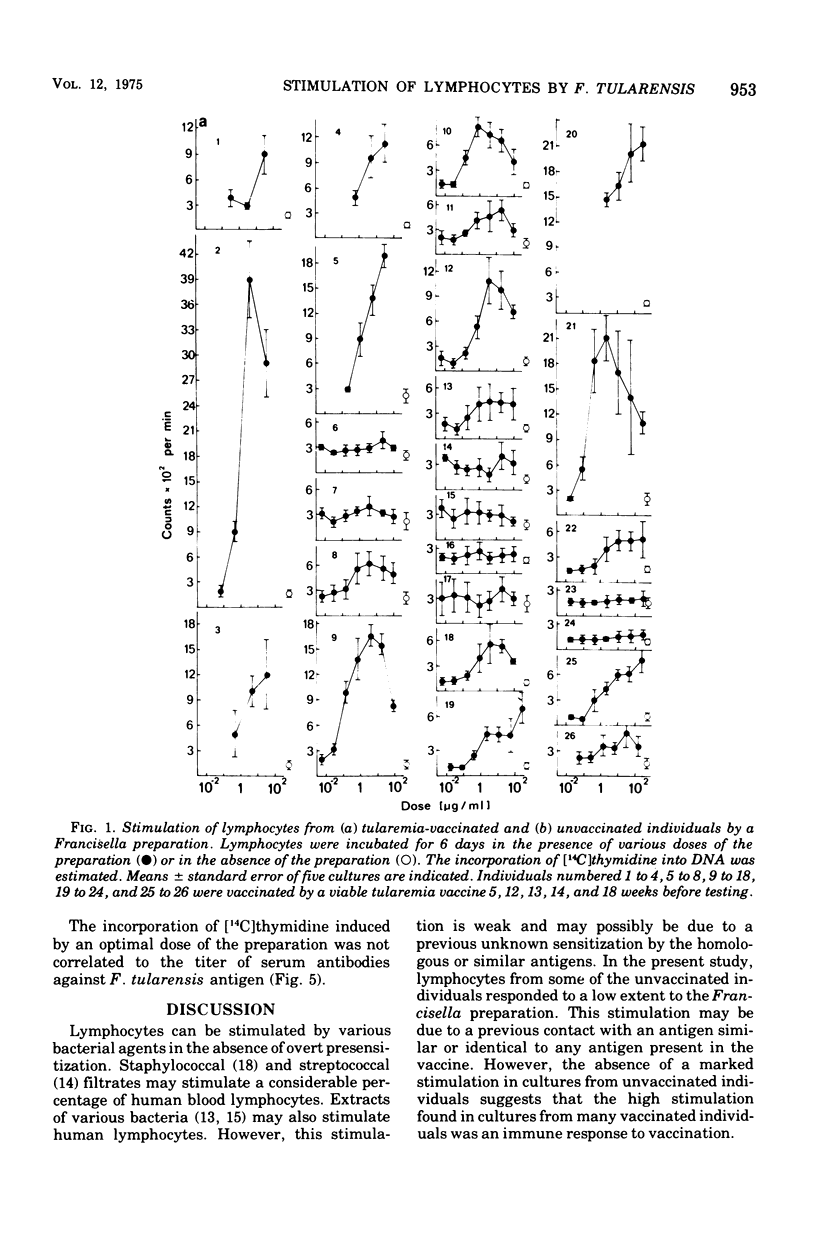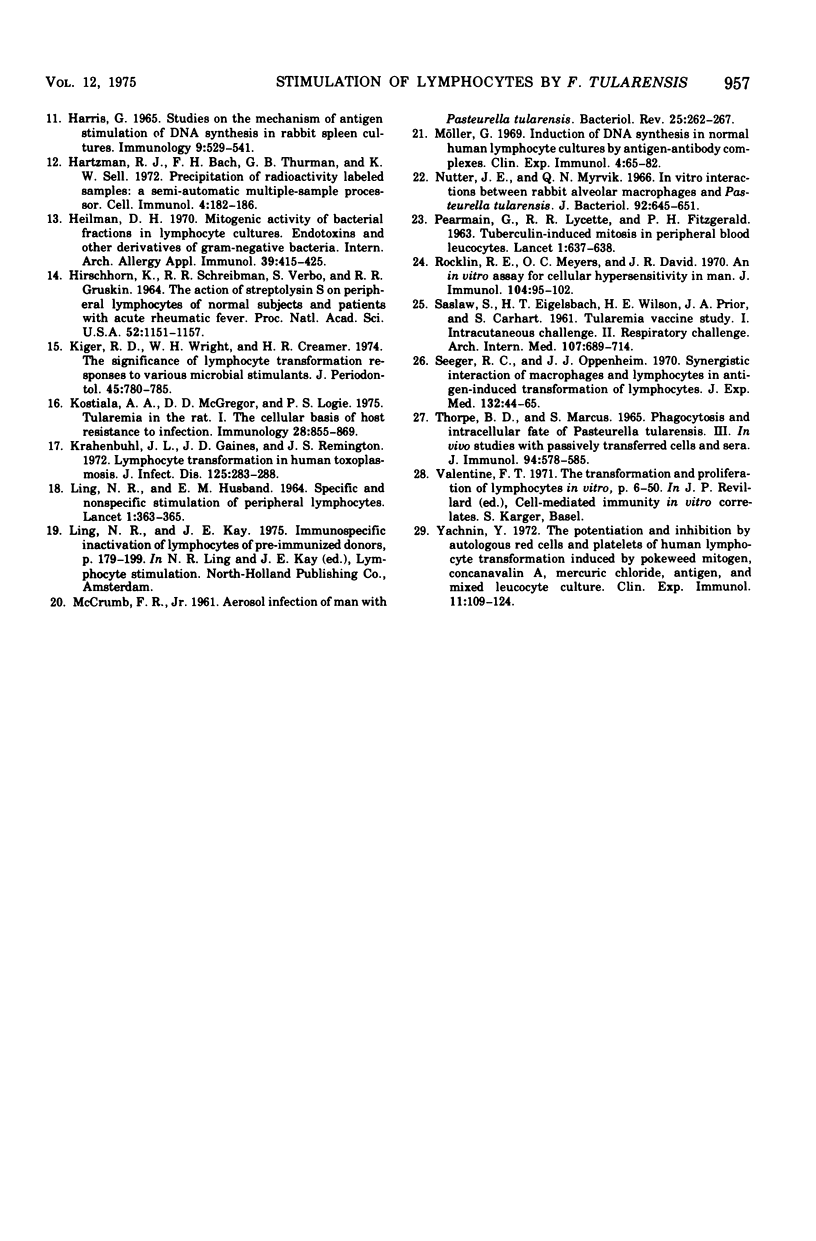Abstract
An immune response to Francisella tularensis was demonstrated in man by the lymphocyte stimulation test. Peripheral blood lymphocytes were obtained from 26 individuals vaccinated with a viable tularemia vaccine, from 29 unvaccinated individuals, and from two patients who had recently undergone tularemia. The lymphocytes were incubated in the presence of various dilutions of heat-killed bacteria of the vaccine strain. The bacteria induced a deoxyribonucleic acid synthesis in the lymphocytes from 18 of the vaccinated individuals and from the two patients which was higher than that in the lymphocytes from any of the unvaccinated individuals. The deoxyribonucleic acid synthesis was maximal after about 6 days of incubation irrespective of concentration of bacteria. Lymphocytes from vaccinated and unvaccinated individuals were stimulated by two unrelated agents, tuberculin purified protein derivative and pokeweed mitogen. Lymphocytes from the vaccinated individuals did not show a higher response to these agents than did those of the unvaccinated. This suggests that the lymphocyte response to the Francisella bacteria was not due to a nonspecific activation. The vaccine-induced lymphocyte stimulation did not correlate with serum antibodies agglutinating F. tularensis antigen.
Full text
PDF






Selected References
These references are in PubMed. This may not be the complete list of references from this article.
- ALLEN W. P. Immunity against tularemia: passive protection of mice by transfer of immune tissues. J Exp Med. 1962 Feb 1;115:411–420. doi: 10.1084/jem.115.2.411. [DOI] [PMC free article] [PubMed] [Google Scholar]
- Bloch-Shtacher N., Hirschhorn K., Uhr J. W. The response of lymphocytes from non-immunized humans to antigen-antibody complexes. Clin Exp Immunol. 1968 Nov;3(9):889–899. [PMC free article] [PubMed] [Google Scholar]
- Buchanan T. M., Brooks G. F., Brachman P. S. The tularemia skin test. 325 skin tests in 210 persons: serologic correlation and review of the literature. Ann Intern Med. 1971 Mar;74(3):336–343. doi: 10.7326/0003-4819-74-3-336. [DOI] [PubMed] [Google Scholar]
- COULSON A. S., CHALMERS D. G. SEPARATION OF VIABLE LYMPHOCYTES FROM HUMAN BLOOD. Lancet. 1964 Feb 29;1(7331):468–469. doi: 10.1016/s0140-6736(64)90799-8. [DOI] [PubMed] [Google Scholar]
- Claflin J. L., Larson C. L. Infection-immunity in tularemia: specificity of cellular immunity. Infect Immun. 1972 Mar;5(3):311–318. doi: 10.1128/iai.5.3.311-318.1972. [DOI] [PMC free article] [PubMed] [Google Scholar]
- Coulson A. S., Chalmers D. G. Quantitation of peripheral blood lymphocyte cultures. Nature. 1966 Jan 22;209(5021):378–381. doi: 10.1038/209378a0. [DOI] [PubMed] [Google Scholar]
- EIGELSBACH H. T., DOWNS C. M. Prophylactic effectiveness of live and killed tularemia vaccines. I. Production of vaccine and evaluation in the white mouse and guinea pig. J Immunol. 1961 Oct;87:415–425. [PubMed] [Google Scholar]
- GASPAR A. J., TRESSELT H. B., WARD M. K. New solid medium for enhanced growth of Pasteurella tularensis. J Bacteriol. 1961 Oct;82:564–569. doi: 10.1128/jb.82.4.564-569.1961. [DOI] [PMC free article] [PubMed] [Google Scholar]
- Gurvich E. B., Svet-Moldavskaya I. A. Transformation of human blood lymphocytes under the influence of smallpox antigen. Nature. 1968 Dec 7;220(5171):1050–1051. doi: 10.1038/2201050a0. [DOI] [PubMed] [Google Scholar]
- HIRSCHHORN K., SCHREIBMAN R. R., VERBO S., GRUSKIN R. H. THE ACTION OF STREPTOLYSIN S ON PERIPHERAL LYMPHOCYTES OF NORMAL SUBJECTS AND PATIENTS WITH ACUTE RHEUMATIC FEVER. Proc Natl Acad Sci U S A. 1964 Nov;52:1151–1157. doi: 10.1073/pnas.52.5.1151. [DOI] [PMC free article] [PubMed] [Google Scholar]
- Harris G. Studies of the mechanism of antigen stimulation of DNA synthesis in rabbit spleen cultures. Immunology. 1965 Dec;9(6):529–541. [PMC free article] [PubMed] [Google Scholar]
- Hartzman R. J., Bach M. L., Bach F. H., Thurman G. B., Sell K. W. Precipitation of radioactively labeled samples: a semi-automatic multiple-sample processor. Cell Immunol. 1972 Jun;4(2):182–186. doi: 10.1016/0008-8749(72)90018-4. [DOI] [PubMed] [Google Scholar]
- Heilman D. H. Mitogenic activity of bacterial fractions in lymphocyte cultures. Endotoxins and other derivatives of gram-negative bacteria. Int Arch Allergy Appl Immunol. 1970;39(4):415–425. doi: 10.1159/000230369. [DOI] [PubMed] [Google Scholar]
- Kiger R. D., Wright W. H., Creamer H. R. The significance of lymphocyte transformation responses to various microbial stimulants. J Periodontol. 1974 Nov;45(11):780–785. doi: 10.1902/jop.1974.45.11.780. [DOI] [PubMed] [Google Scholar]
- Kostiala A. A., McGregor D. D., Logie P. S. Tularaemia in the rat. I. The cellular basis on host resistance to infection. Immunology. 1975 May;28(5):855–869. [PMC free article] [PubMed] [Google Scholar]
- Krahenbuhl J. L., Gaines J. D., Remington J. S. Lymphocyte transformation in human toxoplasmosis. J Infect Dis. 1972 Mar;125(3):283–288. doi: 10.1093/infdis/125.3.283. [DOI] [PubMed] [Google Scholar]
- LING N. R., HUSBAND E. M. SPECIFIC AND NON-SPECIFIC STIMULATION OF PERIPHERAL LYMPHOCYTES. Lancet. 1964 Feb 15;1(7329):363–365. doi: 10.1016/s0140-6736(64)92102-6. [DOI] [PubMed] [Google Scholar]
- McCrumb F. R. AEROSOL INFECTION OF MAN WITH PASTEURELLA TULARENSIS. Bacteriol Rev. 1961 Sep;25(3):262–267. doi: 10.1128/br.25.3.262-267.1961. [DOI] [PMC free article] [PubMed] [Google Scholar]
- Nutter J. E., Myrvik Q. N. In vitro interactions between rabbit alveolar macrophages and Pasteurella tularensis. J Bacteriol. 1966 Sep;92(3):645–651. doi: 10.1128/jb.92.3.645-651.1966. [DOI] [PMC free article] [PubMed] [Google Scholar]
- PEARMAIN G., LYCETTE R. R., FITZGERALD P. H. Tuberculin-induced mitosis in peripheral blood leucocytes. Lancet. 1963 Mar 23;1(7282):637–638. doi: 10.1016/s0140-6736(63)91275-3. [DOI] [PubMed] [Google Scholar]
- Rocklin R. E., Meyers O. L., David J. R. An in vitro assay for cellular hypersensitivity in man. J Immunol. 1970 Jan;104(1):95–102. [PubMed] [Google Scholar]
- SASLAW S., EIGELSBACH H. T., WILSON H. E., PRIOR J. A., CARHART S. Tularemia vaccine study. I. Intracutaneous challenge. Arch Intern Med. 1961 May;107:689–701. doi: 10.1001/archinte.1961.03620050055006. [DOI] [PubMed] [Google Scholar]
- Seeger R. C., Oppenheim J. J. Synergistic interaction of macrophages and lymphocytes in antigen-induced transformation of lymphocytes. J Exp Med. 1970 Jul 1;132(1):44–65. doi: 10.1084/jem.132.1.44. [DOI] [PMC free article] [PubMed] [Google Scholar]
- THORPE B. D., MARCUS S. PHAGOCYTOSIS AND INTRACELLULAR FATE OF PASTEURELLA TULARENSIS. 3. IN VIVO STUDIES WITH PASSIVELY TRANSFERRED CELLS AND SERA. J Immunol. 1965 Apr;94:578–585. [PubMed] [Google Scholar]
- Yachnin S. The potentiation and inhibition by autologous red cells and platelets of human lymphocyte transformation induced by pokeweed mitogen concanavalin A, mercuric chloride, antigen, and mixed leucocyte culture. Clin Exp Immunol. 1972 May;11(1):109–124. [PMC free article] [PubMed] [Google Scholar]


